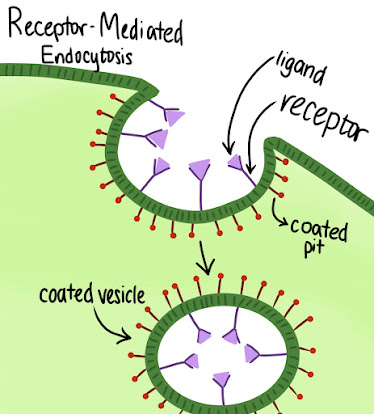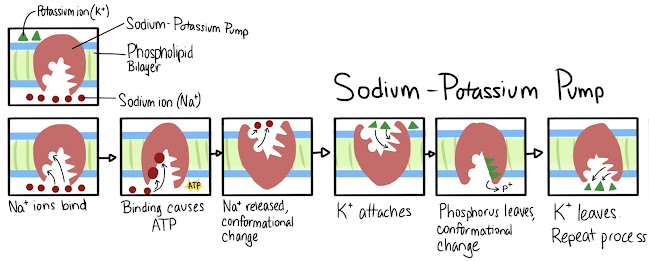Transport
There are two types of transport that occur between cells: passive and active transport.
Passive Transport - Molecules naturally move from an area of high concentration to low concentration. This does not use energy. There are 3 types of passive transport: simple diffusion, facilitated diffusion, and osmosis.
- Simple Diffusion: Small and nonpolar molecules more from an area of high to low concentration. If there is more than one solute, then those solutes will be equally distributed across a membrane. These molecules will be able to easily pass through the membrane, which is why it's called simple diffusion: nothing is needed to help it pass through.
- Facilitated Diffusion: Polar molecules and ions impeded by the bilayer of the membrane are diffused passively with the help of transport proteins spanning the membrane. Diffusion will occur through protein channels. Again, it moves from high concentration to low concentration. If a large amount of glucose needs to enter the cell (remember: glucose is polar!) it can't just enter the cell as it will be repelled by the nonpolar tails of the phospholipids. In addition, glucose is a large molecule and can't fit between small gaps like salt would, for instance. Therefore, glucose would need a protein to help it enter the cell. This protein would be like a straw through the membrane - the inside is polar, where the glucose can easily pass through. In this way, the solute (glucose) is being helped to cross the membrane (facilitation)!
- Osmosis: This is for water only, not solutes. Osmosis can take the form of both simple and facilitated diffusion. Water moves from an area of high free water concentration to low free water concentration. For instance, if you have a U-Shaped container filled with equal amounts of water on both sides of the U (and a semi-permeable membrane divided these sides down the middle of the U), but add more sugar to one section, the water will move to the side with more sugar in it (since the sugar can't go through the membrane). This way, there is an equal amount of solute per solvent.
Active Transport: This type of transport uses energy (ATP). It moves from low to high. That means it is going against the gradient. Imagine you're a fish going upstream instead of downstream. The current will obviously be going downstream - going with the current (the gradient) will be easy because the water is already moving in that direction and will push you along without any effort from yourself. However, going upstream, against the current, would be very difficult and you'd use a lot of energy trying to accomplish this. In the same way, a solute going against the gradient to an area of high concentration will use energy (ATP). Therefore, it is called active transport: you're actively using energy to be transported. There are multiple types of active transport: receptor-mediated endocytosis, pinocytosis, phagocytosis, exocytosis, and protein pumps.
- Receptor-Mediated Endocytosis: Cells will absorb specific molecules. There are things called receptors found on the outside of the cell membrane. When these receptors bind with a ligand (a molecule that binds to a protein; in this case, a signaling molecule), the cell is alerted to the molecule's arrival and takes it in via a vesicle. The plasma membrane will make a bubble where it will be carried to an organelle in the cell.
- Pinocytosis: The cell will "gulp" droplets of extracellular fluid in vesicles (made from the plasma membrane), and dissolves solutes, sugars, proteins, and liquids.
- Phagocytosis: The cell engulfs a particle and packages it into a food vacuole; this will be digested by a lysosome.
- Exocytosis: The cell will excrete particles via a secretory vesicle. The bubble formed by the plasma membrane will likely be digested or reused.
- Proton Pumps: ATP is used to pump protons against their gradient.
- Sodium-Potassium Pump: Another type of pump involving the release of sodium and potassium ions. Notice that binding causes conformational changes! Click on the image to enlarge.
Now for the joke!
Why did the scarecrow win an award?
Next up: Tonicity!










So phagocytosis is the same as pinocytosis, but for food instead of liquid?
ReplyDeleteYup! A phagocyte (immune cell) will do phagocytosis to ingest foreign particles, so it's not just food bring ingested in phagocytosis but also other materials.
DeleteWhich cells use the NaK pump?
ReplyDeleteTypically neuron cells.
DeleteYou said simple/facillitated diffusion is only for molecules and osmosis is only for water, so how can osmosis also be simple/facilitated diffusion?
ReplyDeleteOsmosis can use essentially the idea of simple/facilitated diffusion (as in, water molecules can permeate the membrane in small quantities [simple] or enter the cell in large quantities via a protein [facilitated].) Osmosis is unique to only water - other molecules can't use osmosis. Hope that helps!
Deleteare transport proteins always active and transporting molecules inside the cell even if the cell is like full to capacity?
ReplyDeleteNope! Signals will tell the proteins to stop taking in molecules if the cell is likely to burst.
DeleteWhy isn't facilitated diffusion (passive transport) using ATP? A protein is being used there.
ReplyDeleteJust because a protein is used doesn't mean ATP is used.
Delete1) It's going with the gradient, not against it, so ATP will not be used.
2) The protein itself is just a channel and is not activated with ATP.